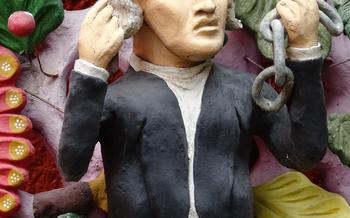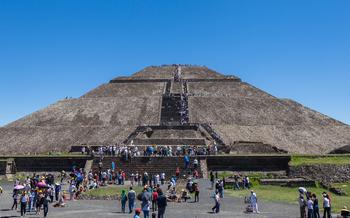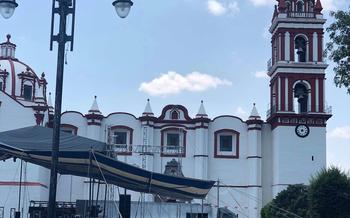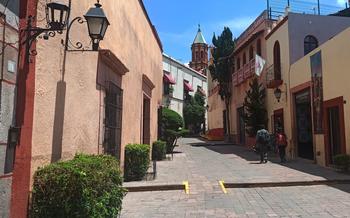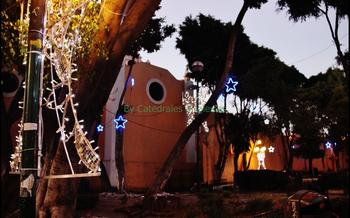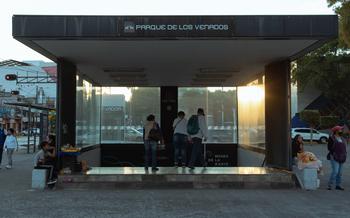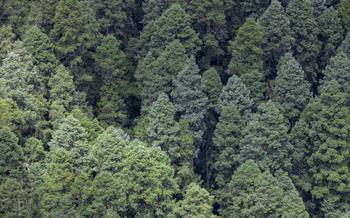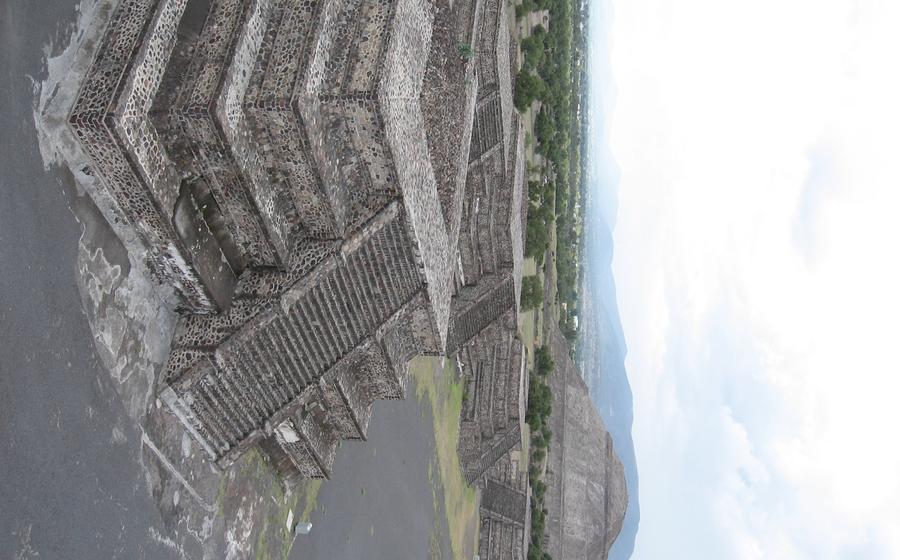
Iztaccíhuatl Volcano
- Iztaccíhuatl Volcano: A Sleeping Beauty
- Climbing Iztaccíhuatl: A Challenging Adventure
- Preparing for the Climb: Essential Gear and Training
- Reaching the Base Camp: La Joya
- Ascending the Volcano: La Arista del Sol Route
- Reaching the Summit: A Breathtaking Achievement
- Exploring the Izta-Popo National Park
- Visiting the Neighboring Volcano: Popocatépetl
- Cultural Immersion in Amecameca
- Photography Tips for Capturing the Beauty
- Responsible Tourism and Conservation
- Insider Tip: Off-the-Beaten-Path Exploration
Iztaccíhuatl Volcano: A Sleeping Beauty
The Iztaccíhuatl Volcano, also known as the "White Woman" or "Sleeping Woman" due to its resemblance to a reclining female figure, is an iconic landmark in Mexico and a symbol of love and resilience. Towering at an altitude of 5,286 meters (17,343 feet), it is the third-highest peak in North America and a popular destination for mountaineers, nature enthusiasts, and history buffs.
Legends and myths surround the majestic volcano, weaving a tapestry of love, sacrifice, and divine intervention. One of the most famous tales is that of Iztaccíhuatl and her beloved Popocatépetl, two Aztec warriors whose tragic love story transformed them into eternal guardians of the land.
Geologically, Iztaccíhuatl is a stratovolcano, formed by layers of lava and ash from multiple eruptions. Its slopes are adorned with diverse vegetation, ranging from lush forests at the base to alpine meadows and barren volcanic landscapes at higher elevations.
The climate of the volcano is characterized by distinct seasons, with warm and dry conditions during the spring and summer, and cold and snowy conditions during the winter. The rainy season typically occurs from May to October, bringing lush greenery to the region.
Access to Iztaccíhuatl is restricted, and permits are required for climbing. Visitors must register with the local authorities and obtain the necessary permits before embarking on their journey. Several routes lead to the summit, each offering unique challenges and scenic vistas.
Climbing Iztaccíhuatl: A Challenging Adventure
The ascent of Iztaccíhuatl is a thrilling challenge for experienced mountaineers and outdoor enthusiasts. The climb requires endurance, technical skills, and a deep respect for the mountain's unpredictable nature.
The difficulty level of the climb varies depending on the route and weather conditions, but it generally requires a good level of fitness, proper acclimatization, and previous experience in high-altitude mountaineering. Beginners should consider hiring a professional guide to ensure a safe and successful ascent.
The best time to climb Iztaccíhuatl is during the dry season, which runs from November to April. During this period, the weather is generally stable, with clear skies and less precipitation. However, climbers should be prepared for sudden changes in weather conditions, especially at higher altitudes.
There are several routes to choose from, each offering unique challenges and rewards. The most popular and scenic route is La Arista del Sol, which takes climbers along the southern ridge of the volcano. Other routes include La Cara Norte, a more challenging and technical climb, and La Cara Este, a less frequented route that offers stunning views of the surrounding landscapes.
Preparing for the Climb: Essential Gear and Training
Conquering Iztaccíhuatl demands meticulous preparation, starting with the right gear. Pack layers of clothing to adapt to changing temperatures, including a waterproof jacket and pants for unpredictable weather. Sturdy hiking boots with ankle support are essential, as well as gloves, a warm hat, and sunglasses. Don't forget a headlamp for navigating in low-light conditions.
Physical fitness plays a crucial role in your success. Train your endurance and stamina with regular cardio workouts. Incorporate strength training to build strong legs and core muscles, which are vital for tackling steep slopes. Begin training several months in advance to ensure your body is well-prepared for the challenge.
Acclimatization to high altitude is paramount. Spend a few days at higher elevations before attempting the climb. This allows your body to adjust to the reduced oxygen levels and minimize the risk of altitude sickness. Drink plenty of fluids and consume high-energy foods to stay hydrated and energized.
Finally, secure the necessary permits from the Izta-Popo National Park authorities. Check the park website for regulations and fees. Consider purchasing travel insurance to protect yourself against unforeseen circumstances.
Reaching the Base Camp: La Joya
Nestled at an elevation of 4,600 meters, La Joya serves as the base camp for climbers attempting the ascent of Iztaccíhuatl. This rustic yet well-equipped camp provides a sanctuary for climbers to acclimatize to the altitude, prepare for the challenging climb ahead, and receive essential safety briefings.
La Joya offers a range of camping options, from simple tent sites to cozy cabins, catering to climbers' preferences and budget. Basic amenities such as restrooms, a dining area, and a first-aid station are available, ensuring a comfortable and safe stay.
During your time at La Joya, take advantage of the acclimatization activities offered to help your body adjust to the high altitude. These activities may include short hikes in the surrounding area, light exercise sessions, and yoga classes specifically designed for climbers.
Before embarking on your climb, attend the mandatory briefing conducted by experienced guides. They will provide detailed information about the route, safety protocols, weather conditions, and any potential hazards you may encounter during your ascent. Listen attentively and follow their instructions carefully for a successful and safe climb.
Ascending the Volcano: La Arista del Sol Route
The most popular and scenic route to climb Iztaccíhuatl is La Arista del Sol, or "Ridge of the Sun." This route offers breathtaking views of the surrounding landscape, including the neighboring Popocatépetl volcano. It begins at La Joya base camp and follows a well-defined trail that leads up the mountain's south side.
Along the way, climbers will pass several key landmarks, including the Refugio de los Cien ("Refuge of the Hundred"), a mountain hut where climbers can rest and acclimatize. They will also encounter challenging sections, such as the steep and rocky La Rampa ("The Ramp") and the icy and crevassed La Arista ("The Ridge").
Navigating the glacier and snowfields requires caution and proper equipment, including ice axes and crampons. Climbers should also maintain a steady pace and stay hydrated to avoid altitude sickness and fatigue. Patience and perseverance are key to reaching the summit of Iztaccíhuatl, but the rewards are immense.
Reaching the Summit: A Breathtaking Achievement
The long-awaited moment arrives as you reach the summit of Iztaccíhuatl, a remarkable achievement that crowns your strenuous climb. The breathtaking panorama that unfolds before your eyes is a symphony of natural beauty, with the surrounding peaks, valleys, and forests painting an awe-inspiring canvas. The sense of accomplishment washes over you, the culmination of your physical and mental efforts.
Take a moment to savor the triumph, to revel in the realization that you've conquered one of Mexico's most iconic peaks. Allow the crisp mountain air to fill your lungs, invigorating your senses and heightening the exhilaration of the experience. Capture the essence of this moment with photographs, preserving the memory of your hard-earned victory.
As you stand atop Iztaccíhuatl, the legendary Sleeping Beauty, you become part of the rich tapestry of stories and legends that have woven themselves around this majestic volcano. Let the spirit of the mountain embrace you, inspiring you to embrace new challenges and to always strive for greatness.
But amidst the celebration, remember the importance of safety. Altitude sickness can still pose a threat, so be mindful of your body's signals and descend promptly if you experience any symptoms. Embrace the joy of the summit, but always prioritize your well-being.
Exploring the Izta-Popo National Park
Encompassing the majestic volcanoes Iztaccíhuatl and Popocatépetl, the Izta-Popo National Park is a haven for nature enthusiasts and adventure seekers. The park boasts a diverse array of ecosystems, ranging from lush forests to arid deserts, offering breathtaking landscapes and a rich tapestry of flora and fauna.
One of the main attractions of the park is wildlife spotting. The diverse habitats support a variety of animal species, including coyotes, rabbits, squirrels, and a variety of bird species. Visitors can embark on birdwatching expeditions to spot colorful species such as hummingbirds, eagles, and hawks soaring through the skies.
The park also offers a network of hiking trails, catering to hikers of all levels. Whether you prefer leisurely strolls or challenging treks, you'll find a trail that suits your abilities. The trails wind through picturesque landscapes, offering panoramic views of the volcanoes and the surrounding countryside.
For those seeking a more immersive experience, camping and picnicking areas are available within the park. Imagine waking up to the stunning views of the volcanoes or enjoying a picnic lunch surrounded by nature's beauty. Remember to pack your tent, sleeping bag, and all the necessary camping gear for a comfortable stay.
Visiting the Neighboring Volcano: Popocatépetl
Popocatépetl, the active neighbor of Iztaccíhuatl, offers a unique and thrilling experience for adventurous travelers. With an elevation of 5,426 meters, it is the second-highest peak in Mexico and an active volcano that demands respect and caution. Despite its active status, hiking trails and viewpoints are accessible, allowing visitors to witness the awe-inspiring power of nature up close.
Before embarking on a Popocatépetl adventure, it is essential to check the volcano's activity level and heed any warnings or restrictions issued by local authorities. Safety precautions and proper gear are paramount, including protective clothing, sturdy hiking boots, and a gas mask in case of ash or gas emissions.
The ascent to Popocatépetl is a challenging but rewarding endeavor. The trail winds through diverse landscapes, from lush forests to barren lava fields, offering breathtaking vistas at every turn. The views from the summit are simply mesmerizing, as you stand atop an active volcano, surrounded by stunning mountain scenery.
It is important to note that Popocatépetl is an active volcano, and eruptions can occur without warning. While the volcano is closely monitored, visitors should be prepared for sudden changes in conditions and be willing to evacuate if necessary. Permits and regulations are in place to ensure the safety of hikers and climbers, and it is mandatory to obtain the necessary permits before attempting an ascent.
Cultural Immersion in Amecameca
Nestled at the foot of the Iztaccíhuatl Volcano, the charming town of Amecameca offers a vibrant blend of culture, history, and natural beauty. Immerse yourself in the local traditions by exploring the traditional markets, where you can find an array of colorful artesanía, from intricate pottery to handwoven textiles. Discover the town's rich history at the Museo Histórico de Amecameca, which houses artifacts and exhibits showcasing the region's pre-Hispanic and colonial past.
Indulge in the delectable local cuisine, which boasts dishes such as barbacoa, a slow-cooked lamb or goat delicacy, and pulque, a traditional fermented beverage made from the sap of the maguey plant. Take part in the lively festivals and celebrations that take place throughout the year, including the annual Feria de Amecameca, which features traditional dances, music, and food. Venture beyond the town center to explore nearby attractions such as the Santuario del Sacromonte, a 16th-century church perched atop a hill with panoramic views of the Iztaccíhuatl and Popocatépetl volcanoes. Embark on a day trip to the nearby villages of Tlalmanalco and Atlautla, where you can witness traditional Otomi and Nahua rituals and ceremonies.
Photography Tips for Capturing the Beauty
The stunning landscapes of Iztaccíhuatl and Popocatépetl offer endless opportunities for photography enthusiasts. To capture the essence of these majestic volcanoes, consider the following tips:
-
Golden Hour Magic: Plan your shoot during the golden hours of sunrise and sunset when the warm light casts a magical glow on the mountains.
-
Composition and Perspective: Experiment with different angles and perspectives to create dynamic compositions. Use foreground elements like rocks or trees to add depth and scale.
-
Capturing the Essence: Focus on the unique features of each volcano, such as the glaciers on Iztaccíhuatl or the smoking crater of Popocatépetl. Convey the sense of scale and grandeur through wide-angle shots.
-
Filters and Lenses: Utilize filters to enhance colors and create dramatic effects. Consider using a telephoto lens to capture close-up shots of wildlife or distant landscapes.
Responsible Tourism and Conservation
When exploring the natural wonders of Iztaccíhuatl and its surroundings, it's essential to practice responsible tourism and conservation. Minimize your environmental impact by packing out all trash and avoiding disturbing wildlife. Respect local customs and traditions, and support sustainable tourism initiatives that benefit the community. Preserving the natural beauty of this region for future generations is a shared responsibility. Remember, the beauty of these places is a privilege, and we must all do our part to protect it.
Insider Tip: Off-the-Beaten-Path Exploration
Beyond the popular trails and viewpoints, the Iztaccíhuatl-Popocatépetl region offers a wealth of hidden gems and off-the-beaten-path adventures for those seeking a more immersive and authentic experience. Venture into lesser-known trails that lead to secluded viewpoints, where you can enjoy panoramic vistas without the crowds. Discover hidden waterfalls, pristine lakes, and ancient ruins that reveal the region's rich history and cultural heritage.
Interact with local communities to gain insights into their traditions, way of life, and the unique challenges they face living in this volcanic landscape. Engage in conversations, learn about their customs, and support their local initiatives. Attend local festivals, markets, and events to immerse yourself in the vibrant culture and traditions of the region.
By exploring beyond the tourist trail, you not only create unique and memorable experiences but also contribute to the preservation and sustainability of the region. You support local businesses, promote cultural exchange, and minimize the environmental impact of tourism. Embrace the spirit of adventure and discover the hidden treasures of the Iztaccíhuatl-Popocatépetl region, leaving a positive impact while creating lasting memories.
